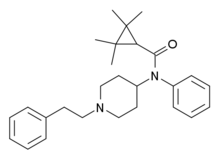Tetramethylcyclopropylfentanyl
 | |
| Legal status | |
|---|---|
| Legal status |
|
| Identifiers | |
| |
| CAS Number | |
| UNII | |
| Chemical and physical data | |
| Formula | C27H36N2O |
| Molar mass | 404.598 g·mol−1 |
| 3D model (JSmol) | |
| |
Tetramethylcyclopropylfentanyl is an opioid analgesic that is an analog of fentanyl and has been sold as a designer drug.[2]
Side effects[edit]
Side effects of fentanyl analogs are similar to those of fentanyl itself, which include itching, nausea and potentially serious respiratory depression, which can be life-threatening. Fentanyl analogs have killed hundreds of people throughout Europe and the former Soviet republics since the most recent resurgence in use began in Estonia in the early 2000s, and novel derivatives continue to appear.[3] A new wave of fentanyl analogues and associated deaths began in around 2014 in the US, and have continued to grow in prevalence; especially since 2016 these drugs have been responsible for hundreds of overdose deaths every week.[4]
Legal status[edit]
In the United States, fentanyl-related substances are Schedule I controlled substances.[1] Tetramethylcyclopropylfentanyl was banned in Finland in September 2017,[5] and in Sweden in October 2017.[6]
See also[edit]
References[edit]
- ^ a b Drug Enforcement Administration, Department of Justice (2018). "Schedules of Controlled Substances:Temporary Placement of Fentanyl-Related Substances in Schedule I. Temporary amendment; temporary scheduling order". Federal Register. 83 (25): 5188–92. PMID 29932611.
- ^ Augustin SD. Identification Of Fentanyl-Type Opioids Using GC-MS Fragmentation Data. Cayman Chemical, 21 August 2017
- ^ Mounteney J, Giraudon I, Denissov G, Griffiths P (July 2015). "Fentanyls: Are we missing the signs? Highly potent and on the rise in Europe". The International Journal on Drug Policy. 26 (7): 626–31. doi:10.1016/j.drugpo.2015.04.003. PMID 25976511.
- ^ Armenian P, Vo KT, Barr-Walker J, Lynch KL (October 2017). "Fentanyl, fentanyl analogs and novel synthetic opioids: A comprehensive review". Neuropharmacology. 134 (Pt A): 121–132. doi:10.1016/j.neuropharm.2017.10.016. PMID 29042317. S2CID 21404877.
- ^ European Commission. Notification detail. Government Decree amending Annex IV to the Government Decree on substances, preparations and plants to be classified as narcotics The following 9 new substances are classified: 4-chloro-isobutyrfentanyl, 4-Fluoro-isobutyrfentanyl, 3-phenylpropanoylfentanyl, benzodioxole fentanyl, benzoyl fentanyl, cyclopentyl fentanyl, cyclopropyl fentanyl, methoxyacetyl fentanyl and tetramethylcyclopropyane fentanyl. 12 September 2017
- ^ The Public Health Agency of Sweden. 14 nya ämnen kan klassas som narkotika eller hälsofarlig vara. 14 October 2017
